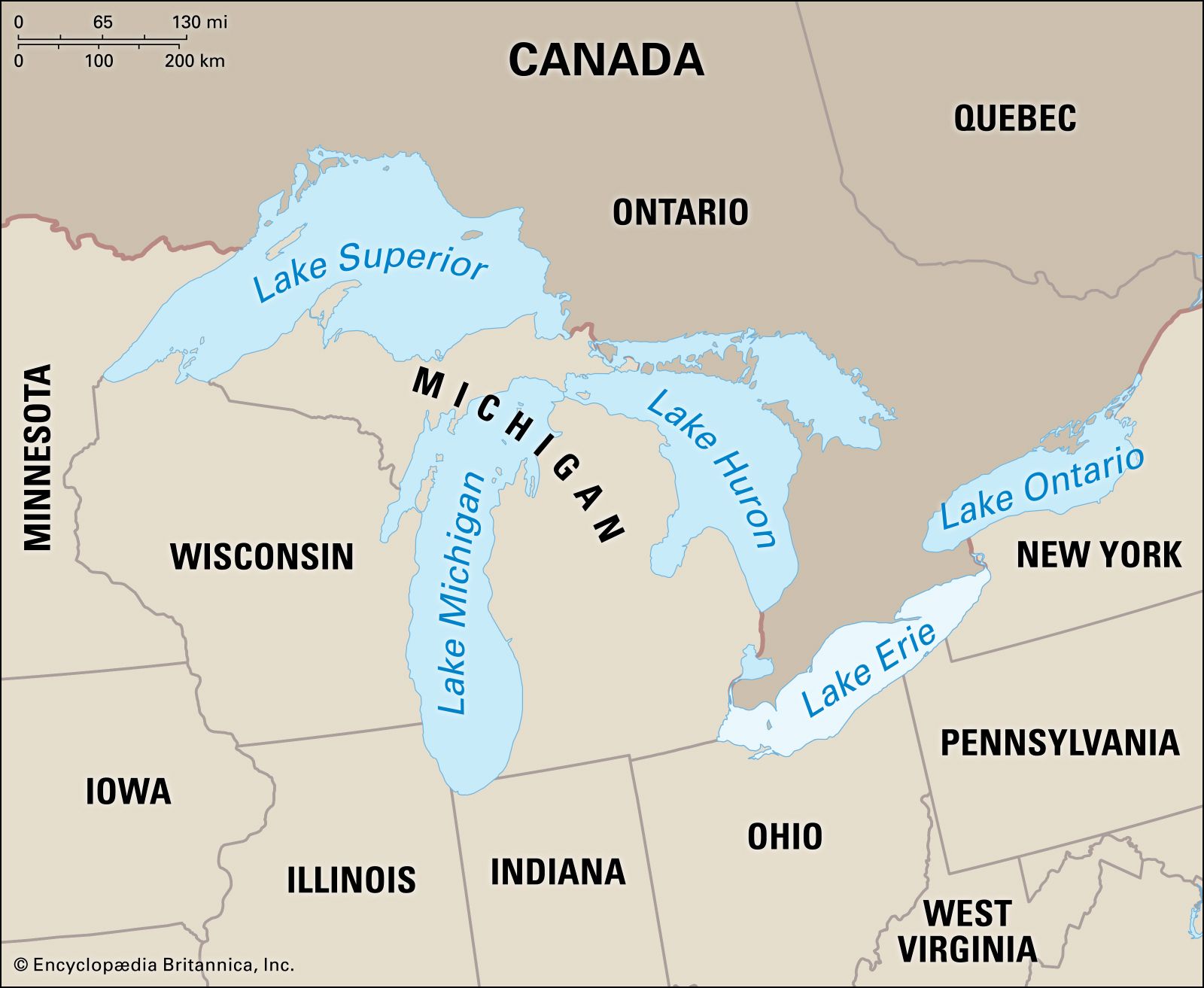
Great Lakes: Erie Facts, Map Insights, and Name Origins

The Great Lakes, which include Lakes Superior, Michigan, Huron, Erie, and Ontario, form the largest collection of freshwater lakes in the world, covering a total area of over 94,000 square miles. Among these, Lake Erie is particularly significant due to its relatively shallow depth, making it the warmest and most biologically productive of all the lakes. This article will provide insights into the various facets of the Great Lakes, focusing on their unique climatic influences, environmental challenges, and the geological processes that shaped them.
Understanding the Great Lakes is essential not only for appreciating their natural beauty but also for recognizing their key role in the ecosystem and economy of the surrounding regions. From serving as a crucial source of freshwater to acting as natural borders between the United States and Canada, these lakes continue to impact the lives of millions. In this comprehensive exploration, we will delve into the climatic effects of the Great Lakes, precipitation variability, their geological formation, and the importance of conservation efforts, emphasizing the contributions of Lake Erie within the larger Great Lakes system.
- Overview of the Great Lakes
- The Unique Climate Influence of the Great Lakes
- Water Sources and Precipitation Variability
- Geological Formation of the Great Lakes
- Size and Significance of the Great Lakes
- The Great Lakes as a Natural Border
- Natural Beauty and Industrial Development
- Environmental Challenges and Conservation Efforts
- The Great Lakes and the St. Lawrence Hydrographic System
- Conclusion: The Importance of Protecting the Great Lakes
Overview of the Great Lakes
The Great Lakes comprise five lakes: Lake Superior, Lake Michigan, Lake Huron, Lake Erie, and Lake Ontario. Together, they form a crucial ecological and hydrological system that serves both the United States and Canada. The lakes are interconnected via straits and rivers, with Lake Superior being the largest and most northern lake, followed by Lake Michigan, which is entirely within the United States, and Lake Huron, which borders Canada. Lake Erie is the fourth largest and is known for its role in providing a variety of recreational and economic opportunities.
Geography and Hydrology
Each of the Great Lakes boasts its unique geographical features and hydrological characteristics. The lakes collectively hold about 20% of the world’s unfrozen freshwater supply. Lake Erie, specifically, has a surface area of approximately 9,910 square miles, making it the fourth largest lake by surface area in the United States. Its relatively shallow nature—averaging only about 62 feet deep—contributes to its warm temperatures in the summer and abundant fish populations.
The Unique Climate Influence of the Great Lakes
The Great Lakes have a profound influence on the climate of the surrounding regions. The atmospheric conditions over the lakes result in a moderating effect on temperatures, leading to cooler summers and milder winters. This phenomenon is especially notable around Lake Erie, where the lake's warmth during winter can delay the onset of winter weather, making nearby areas more temperate compared to areas further inland.
Lake Effect Snow
One unique climatic phenomenon associated with the Great Lakes is "lake effect snow." This occurs when cold air sweeps over the warmer waters of the lakes, picking up moisture and depositing it as snow once it reaches the colder land. Lake Erie, due to its proximity to several major cities like Cleveland and Buffalo, often contributes significantly to snow accumulation in those areas, impacting travel and day-to-day life.
Water Sources and Precipitation Variability
The principal sources of water for the Great Lakes are precipitation, surface runoff, and, to a lesser extent, groundwater. However, the amount of precipitation varies substantially across the lakes. For instance, Lake Superior, being situated in a more temperate climate, receives about 30 to 40 inches of precipitation annually, whereas Lake Erie tends to receive around 34 inches, making it less than Lake Ontario, which receives over 40 inches due to its climate conditions.
Impact of Droughts and Floods
Variability in precipitation greatly affects water levels in the Great Lakes. Prolonged periods of drought can lead to significantly lower water levels, affecting shipping routes and ecosystems, while intense rainfall events can cause flooding, leading to shoreline erosion and infrastructure damage. Lake Erie, given its shallow depth, is particularly sensitive to these changes.
Geological Formation of the Great Lakes
The formation of the Great Lakes can be traced back to the last Ice Age, specifically the Pleistocene Epoch, around 14,000 years ago. Glacial activity reshaped the landscape, carving out deep basins that later filled with water as glaciers melted. This geological phenomenon explains the varying depths and characteristics of the lakes, with Lake Erie being the shallowest and youngest of the group.
Glacial Movements and Their Impact
Understanding the geological formations and movements of glaciers provides crucial insights into the current hydrology and ecology of the Great Lakes. The glaciers pushed down from Canada and, as they melted, left behind sediment deposits and other geologic features, contributing to the rich ecosystems found around Lake Erie and its neighboring lakes.
Size and Significance of the Great Lakes
The immense size of the Great Lakes is not only a defining feature but also essential for various aspects of the environment and human activity. Collectively, the lakes provide drinking water for over 40 million people and support countless industries, particularly shipping, fishing, and tourism. Lake Erie, due to its productivity, supports commercial fishing and has several recreational boating areas that draw visitors each year.
Economic Impact
The economic activities around the Great Lakes are significant, with billions of dollars generated annually through shipping and recreational activities alone. The lakes facilitate maritime trade, with major ports in cities such as Cleveland, Detroit, and Buffalo that rely heavily on shipping routes across them, including the movement of goods and raw materials.
The Great Lakes as a Natural Border
The Great Lakes create a natural boundary between the United States and Canada, encompassing parts of eight U.S. states and the Canadian province of Ontario. This has historically provided a shared resource that requires cooperative management and regulation. Lake Erie, in particular, serves as a critical point of entry for both countries' marine and recreational vessels.
Cross-Border Governance
Due to the shared nature of these lakes, cross-border governance is essential. Treaties such as the Great Lakes Water Quality Agreement detail how the U.S. and Canada collaborate to manage water quality and ecosystem health, addressing pollution control and conservation measures crucial for both nations' interests.
Natural Beauty and Industrial Development
The Great Lakes are celebrated for their stunning natural beauty, offering recreational opportunities like swimming, fishing, and boating. This natural allure often contrasts with industrial development, as cities around the lakes have also become hubs for manufacturing and shipping. Lake Erie is notable for its vibrant cities and ports, balancing industrial growth with environmental concerns.
Recreation and Tourism
Aside from industrial activities, the recreational potential of the Great Lakes can’t be overstated. Lakeshores are lined with parks, beaches, and campsites that attract millions of tourists each year, contributing to local economies. Lake Erie is renowned for its fishing, water sports, and scenic parks, making it a prime destination for outdoor enthusiasts.
Environmental Challenges and Conservation Efforts
Despite their significance, the Great Lakes face numerous environmental challenges, including pollution, invasive species, and climate change effects. Curbing pollution from urban runoff, agricultural practices, and industrial discharges is critical for protecting the health of Lake Erie and its surrounding ecosystems.
Invasive Species
Invasive species, such as the zebra mussel and sea lamprey, have drastically altered the ecosystems of the Great Lakes, outcompeting native species and disrupting food chains. Conservation efforts focus on controlling invasive populations and restoring native habitats, particularly around Lake Erie, where such species have had notable impacts on commercial fisheries.
The Great Lakes and the St. Lawrence Hydrographic System
Connecting the Great Lakes to the Atlantic Ocean, the St. Lawrence River serves as a vital hydrographic system that influences water flow and aquatic health. The river basin plays a crucial role in maintaining water levels in the Great Lakes, particularly Lake Erie, which is subject to regulatory mechanisms managing the flow and health of the connected systems.
Importance of Flow Regulation
Regulating the flow of water from the Great Lakes through the St. Lawrence is essential for both environmental and economic reasons. It maintains a balance that supports navigation and protects ecosystems while preventing excessive flooding or water shortages that can devastate local communities and industries.
Conclusion: The Importance of Protecting the Great Lakes
The Great Lakes, particularly Lake Erie, play a critical role in the ecological and economic landscape of North America. Ensuring their health and sustainability requires collective efforts from both the U.S. and Canadian governments, alongside local communities and organizations. Addressing environmental challenges and investing in conservation are paramount for preserving this precious resource for future generations.
The significance of the Great Lakes, their climatic impact, geological history, and interregional hydrography cannot be overstated. As stewards of these lakes, it is our responsibility to protect their beauty and resources, ensuring that Lake Erie and its surroundings continue to thrive.
Did you find this article helpful? Great Lakes: Erie Facts, Map Insights, and Name Origins See more here Education.
Leave a Reply






Related posts